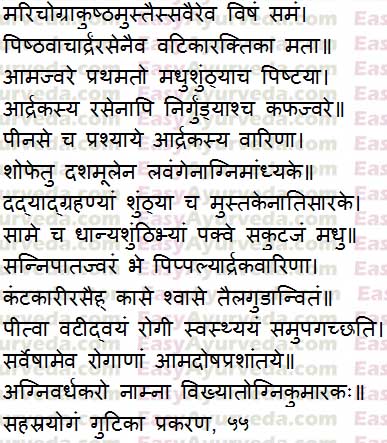Agnikumar ras is an Ayurvedic medicine, with herbal and mineral ingredients, in tablet form. It is used in treating gastro intestinal conditions. This medicine is used more in North Indian Ayurvedic treatment method and should only be taken strictly under medical supervision.
Table of Contents
ToggleBenefits
- It helps to relieve diarrhea, vomiting, indigestion and sprue.
Effect on Tridosha – Balances Vata and Pitta.
Dosage
125 mg – 1 tablet once or twice a day before or after food or as directed by Ayurvedic doctor
With western medicines
Seek your doctor’s advice if you are taking this product along with other western (allopathic/modern) medicines. Some Ayurvedic herbs can interact with modern medicine.
If both Ayurvedic and allopathic medicines are advised together, then it is best to take allopathic medicine first, wait for 30 minutes and then, after a gap of 15 – 30 minutes, take Ayurvedic medicine or as directed by the physician.
Can this be used while taking Homeopathic medicine?
Yes. This product does not react with homeopathic medicine.
With supplements like multivitamin tablets, Omega 3 fatty acids etc?
Yes. Generally, this product goes well with most of the dietary supplements. However, if you are taking more than one product per day, please consult your doctor for an opinion.
Side Effects
- This medicine should only be taken under strict medical supervision.
- Self medication with this medicine may prove to be dangerous.
- It is to be avoided in children and pregnant ladies.
- Make sure to select this medicine from a good company.
- Overdosage may cause side effects like tremors, dizziness etc.
- Make sure to take this medicine only in the prescribed dose and for the prescribed period of time.
Ingredients
Rasendra – Purified and processed Mercury – 1 gram
Gandhaka – Purified and processed Sulphur – 1 gram
Tankana – Purified and processed Borax – 1 gram
Visha – Purified Aconitum ferox – 3 grams
kaparda Bhasma – Bhasma of Cowries – 3 grams
Shankha Bhasma – Conch shell Bhasma – 3 grams
Maricha – Black pepper – Piper nigrum – 8 grams
Method of preparation
First Mercury and Sulphur are ground together, to prepare a black mass, to which the rest of the fine powder of ingredients are added, and ground with lemon juice and pills of 125 mg each is prepared.
Reference
Bhaishajya Ratnavali Agnimandya 10/115-116
Also mentioned in Rasendrasara sangraha
Manufacturers
- Sri Dhootapapeshwar Limited
- Zandu
- Baidyanath
- Dabur
Sahasrayoga Reference
Agnikumara Rasa explained in Sahasrayogam is a simple herbal preparation. It is a unique formulation because it is used to cure many diseases in combination with different adjuvants. It is quite different from Agnikumara Rasa explained in Bhaishajya Ratnavali, Agnimandya prakarana which is a herbo-mineral preparation. Agnikumara in this context is an herbal preparation.
Read – Introduction To Rasashastra: Using Metals And Minerals To Heal
Ingredients –
- Maricha – Piper nigrum – 1 part
- Vacha – Acorus calamus – 1 part
- Kushta – Saussurea lappa – 1 part
- Musta – Cyperus rotundus – 1 part
- Vatsanabha – equal to the quantity of all the above said ingredients – 4 parts
Method of Preparation –
The powders of the above said ingredients are taken in mentioned proportions and pounded with juice of fresh ginger for three days. Pill of the size of 1 gunja i.e. approximately 125 mg are prepared.
Read – Ginger Benefits, Research, Home Remedies, Side Effects
Benefits and therapeutic uses –
It is especially used to destroy ama and to kindle digestive fire, to effectively treat the gastrointestinal and respiratory disorders.
Use of Agnikumara Rasa in different disease conditions with change of adjuvant
Adjuvant is a medium of taking the medicine. The tablet Agnikumara Rasa should be mixed in the adjuvant mentioned as per disease and administered.
Read – Anupan – Co Drinks, After Drinks, Adjuvants For Ayurveda Products
| Sl No | Diseases condition | Adjuvant |
| 1 | Fever caused by ama (Ama Jwara) | Honey, ginger powder and juice of fresh ginger |
| 2 | Fever caused by vitiated kapha (Kapha Jwara) | Juice of Vitex negundo |
| 3 | Rhinitis and Sinusitis (Pinasa and Pratishyaya) | Ginger juice |
| 4 | Swelling, anasarca, inflammatory conditions (Shotha) | Decoction of Dashamula |
| 5 | Weak digestion, indigestion (Agnimandya) | Decoction of clove |
| 6 | Sprue, Mal-absorption, Irritable bowel (Grahani) | Decoction of ginger |
| 7 | Chronic diarrhea (Pakwatisara) | Decoction of Holarrhena antidysenterica, mixed with honey |
| 8 | Fever caused due to simultaneous vitiation of all three doshas (Sannipata Jwara) | Decoction of long pepper (in early stages) |
| 9 | Cough (Kasa) | Fresh juice / decoction of Solanum xanthocarpum |
| 10 | Dyspnea, shortness of breath, asthma, bronchitis (Swasa) | Jaggery mixed with sesame seeds or sesame oil |
Sanskrit Verses

Side Effects and word of caution –
This medicine shall be taken under medical supervision. Self medication might be dangerous. This formulation consists of large dose of Vatsanabha and many people might show altered tolerance to the medication. An experienced Ayurveda physician will guide you properly in consuming this medicine. It should be strictly avoided in children and pregnant women. Tremors, dizziness, headache etc are side-effects of over dosage.
Click to Consult Dr Raghuram Y.S. MD (Ayu) – Skype
Please consult your doctor before taking this medicine.
This article is written by Dr. Janardhana V Hebbar BAMS, MD (Ayu), PGDPSM, Managing Director, Easy Ayurveda Hospital.
It is reviewed by Dr. Shilpa Ramdas BAMS, MD (Ayu), Chief Ayurvedic Physician, Easy Ayurveda Hospital






